The Safety Diet: What Foods Are Bad for Small Animals like Mice, Rats, Guinea Pigs, and Rabbits

Rabbit, Guinea Pig, Rat and Mouse
If you’ve shared your life with a pet, you understand that what goes into their diet greatly influences their well-being. When you’re the caregiver of small animals like mice, rats, guinea pigs, or rabbits, this truth is even more critical. Your little friends rely on a balanced and carefully thought out nutritional plan to lead healthy lives.
However, the internet swarms with information, and not all of it is accurate or consistent. In this guide, we’ll cut through the fluff and elaborate on a no-nonsense list of foods that could spell danger for your furry little friends.
A Halt to Harmful Feeding
Foods bad for Mice: Avoid These on the Platter

Mouse
Mice, known for being frequent nibblers, often rely on their sense of smell to find their next snack. While they’re not too picky, there are certain items that can seriously threaten their health.
Chocolate and caffeine-rich items: Their little bodies can’t handle the stimulants, leading to potential heart and nervous system issues.
Onions and garlic: These common kitchen staples can cause blood abnormalities and digestive upset in mice.
Raw beans: They contain harmful substances that are eliminated through cooking, so raw beans are a no-go.
Citrus fruits: Despite being healthy for humans, the acidity and essential oils found in citrus can harm mice.
Sticky foods like peanut butter in large amounts: It can be tough to consume and potentially lead to choking hazards.
Cheese, contrary to popular belief, isn’t ideal for their diet and can cause digestive problems.
I hope this list helps you craft a safer dining experience for your tiny companions. Remember, watching out for these dietary no-nos is just one way to show your love and ensure their well-being.
Rethinking Rat Rations

Rat
Rats are highly intelligent and social creatures, but when it comes to food, there’s a fine line between a tasty meal and a toxic one.
Here’s what our little rat friends should steer clear of to keep their tiny tummies happy and their whiskers twitching in delight:
Avocado skin and pit: These parts contain persin, which can be toxic to rats. The flesh is okay in moderation, but it’s best to avoid the rest.
Blue cheese: This cheese contains roquefortine C, which can be harmful to rats. It’s best to skip the fancy cheese platter.
Green potatoes: The green parts of potatoes contain solanine, a toxic compound. Always ensure potatoes are ripe and green-free.
Raw sweet potato: Raw sweet potato contains compounds that can be harmful to rats. Cooked is the way to go.
Orange juice: For male rats, orange juice can lead to kidney damage due to d-limonene. It’s best avoided to keep them in tip-top shape.
Licorice: It’s not just a controversial candy; licorice can also be harmful to rats, so better to keep it out of their reach.
Heavy Metal Issue: Rats might be attracted to lead-based paints and old, lead-painted furniture, so be cautious of not just what’s on the dinner plate but where they might access it.
Legume Lament: Like mice, rats should steer clear of raw dry beans for their content of lectins harmful to rodents’ digestive systems.
Forget the Fat: Foods with high-fat content are not just unhealthy but can be dangerous and lead to obesity in rats. High fat foods are good for them or us.
The Guinea Pig Grocery Warning

Guinea Pigs
Guinea pigs are such joys, aren’t they? With their cute little squeaks and cuddly behavior, they quickly become part of the family. Just like any family member, we want to keep them safe and healthy, which brings us to their diet. Despite their willingness to try just about anything you offer, there are some foods you should definitely keep off their menu. Here’s a straightforward rundown of the no-nos for your guinea pig’s diet:
Iceberg lettuce: It might seem like a fresh treat, but it’s mostly water and can cause diarrhea.
Avocado: It’s creamy and delicious for us, but it’s far too rich in fat for our guinea pig pals.
Chocolate: It’s a no-brainer for most pet owners, but it bears repeating—chocolate is toxic to most animals, guinea pigs included.
Caffeinated beverages and foods: The stimulant effect of caffeine is a big no for these little creatures.
Dairy products: Guinea pigs can’t process dairy, so keep the cheese and yogurt for human consumption.
Potatoes and tomato leaves: These belong to the nightshade family and contain substances that can be harmful to guinea pigs.
Onions and garlic: These can cause blood disorders, so it’s best to avoid them.
Candy or any sugary snack: Just like with humans, too much sugar can lead to health issues for guinea pigs.
The Starchy Slip-up: Potatoes and corn should be given in moderation, if at all, as they can cause digestive issues for guinea pigs.
Fruit Fails: While fresh fruits seem like a sweet treat, the high sugar content can upset your guinea pig’s stomach or cause obesity.
By watching out for these dietary pitfalls, you’re showing your guinea pig just how much you care. Remember, it’s all about offering a varied diet that mimics their natural food sources — plenty of hay, some fresh veggies, and a bit of fruit here and there. Thanks for being such awesome guinea pig parents and for always seeking to learn more about their well-being!
Rabbits and Reality Checks

Rabbits are herbivores with sensitive stomachs. It’s critical to understand what foliage they can feast on. In the spirit of keeping our fluffy friends hopping with joy, it’s crucial we chat about what’s not on the bunny-approved snack list. These little hopsters have delicate tummies, so here are a few things to keep out of their meal plan:
Chocolate: Just as with dogs and cats, chocolate is a big no-no for rabbits, containing toxins they can’t metabolize.
Avocado: It’s creamy and dreamy for us, but this fruit is too rich and fatty for rabbits, potentially causing serious health issues.
Iceberg lettuce: While it might seem like a rabbit-friendly veggie, it’s actually low in nutrients and can cause diarrhea in bunnies.
Yogurt drops: They might be marketed toward rabbits, but these sugary treats can lead to digestive problems and obesity.
Bread, pasta, and other processed foods: Rabbits need a diet high in fiber. Processed foods can cause digestive issues and are not nutritious for them.
Cauliflower and cabbage: These can cause gas and bloating, which is uncomfortable and potentially dangerous for rabbits.
Beans and legumes: Not only can these cause gas, but they’re also high in protein and not suitable for rabbits’ digestive systems.
Onions and garlic: Similar to other pets, these can be toxic to rabbits, leading to blood disorders.
Greener Grinch: Rhubarb leaves contain oxalates and can lead to symptoms ranging from stomach pain to kidney failure in rabbits.
Caspian Cucumber: The peel and seeds of cucumbers can be tricky for rabbits to digest, leading to discomfort.
Overdose on Oranges: Citrus could upset a bunny’s digestive system due to its high acidity, leading to pain and a reduction in food intake.
I hope this list helps you in creating a safe and tum-pleasing diet for your bouncy buddies. Remember, the goal is to keep them healthy, happy, and hopping around for a long time. Thanks for caring so much about your furry family members!
Crafting the Right Menu
When it comes to feeding these small animals, a tailored approach is best. Here’s a general plan to ensure they get the nutrition they need.
The Role of Grass Hay: This isn’t just bedding but a critical component of a small pet’s diet. For rabbits and guinea pigs, it should make up the majority of their intake, providing healthy fiber. For mice and rats, it helps wear down their continuously growing teeth.
The Diversity of Veggies: Fresh vegetables should be a daily part of your pet’s meal plan, offering a variety of nutrients. For example, dark leafy greens like spinach and kale are good for rats, while bell peppers and cucumbers are favorites for guinea pigs.
Moderate on the Munchies: Treats are fun, but too many can be detrimental. Stick to controlled portions of healthy options like carrots, apple slices, or broccoli.
Sowing the Seeds of Safety
A nutritional approach is one of the most substantial contributions you can make to your pet’s health. Ensuring that their diet is safe and well-suited to their species can mean the difference between a normal day and a visit to the vet. Remember, you are their source of sustenance and security. Choose wisely, and they will thrive.
Conclusion
We’ve peeled back the layers on what could be harmful when it comes to feeding small animals. With a little knowledge and care, your four-legged friends can enjoy a life free of dietary distress. Always consult with a veterinary professional when in doubt and remember, when it comes to their well-being, you are their all-important advocate and guardian in the world of nutrition. Avoid feeding from the bad lists to create a nutritious diet for your exotic animal practice.
Frequently Asked Questions (FAQ)
Q1: Can I occasionally give my rabbit or guinea pig small quantities of human foods as a treat?
A1: It’s tempting to share your snacks with your fluffy friends, but it’s best to stick to foods suited to their digestive systems. Small amounts of fruits or veggies (that are safe for them) make better treats than processed human food.
Q2: How often should I change up the veggies I feed my pets?
A2: Variety is the spice of life, even for small animals! Aim to introduce new veggies slowly into their diet every few weeks. This not only keeps them excited about their meals but ensures they’re getting a range of nutrients. Just make sure to research each new food to ensure it’s safe for them.
Q3: Are there any common symptoms I should watch out for if I think my pet has eaten something harmful?
A3: Absolutely, keep an eye out for signs like lethargy, diarrhea, changes in eating habits, or any unusual behavior. If you notice any of these, it’s best to consult with your vet as soon as possible.
Q4: Why can’t rabbits eat iceberg lettuce, but darker leafy greens are okay?
A4: Darker leafy greens are packed with nutrients, while iceberg lettuce has a high water content and very little nutritional value. Plus, iceberg can cause digestive issues in rabbits.
Q5: How can I be sure I’m feeding my pet the right amount of food?
A5: Great question! Portion control or daily food allowance depends on the size and age of your pet. It’s best to start with the recommended guidelines from a trusted source or your vet, then adjust as needed based on your pet’s health, activity level, and body condition. When in doubt, asking a professional is always the right move.
Q6: My pet is picky and doesn’t like veggies. What should I do?
A6: Patience is key with picky eaters. Try introducing new veggies slowly, maybe mixed in with some of their favorite foods. Sometimes it takes a bit of creativity. You’re doing great by keeping their diet interesting and healthy!
Remember, your love and care are what make the biggest difference in your pet’s well-being. We’re here for all your questions and love hearing about your little companions. Stay curious, stay caring, and here’s to many joyful years with your pets!





